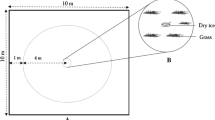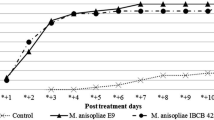Abstract
Dermacentor albipictus (Acari: Ixodidae), the winter tick, is a one-host tick that parasitizes large ungulates. They can dramatically affect moose, Alces alces (Artiodactyla: Cervidae), causing significant physiological and metabolic stress and mortality among heavily parasitized individuals. Entomopathogenic fungi in the genera Metarhizium (Hypocreales: Clavicipitaceae) and Beauveria (Hypocreales: Cordycipitaceae) are promising tick biological control agents. We examined the pathogenicity of experimental and commercially formulated isolates of M. anisopliae, M. brunneum and B. bassiana sprayed at concentrations of 106, 107 and 108 conidia/mL against the larval stage of D. albipictus and assessed the efficacy of spraying the commercial product Met52®EC, containing M. brunneum, strain F52, under laboratory conditions. Results showed larval D. albipictus mortality was significantly higher and occurred earlier when treated with M. anisopliae and M. brunneum isolates compared to B. bassiana at 106, 107 and 108 conidia/mL. Mortality was observed as early as 3 days in the M. anisopliae and M. brunneum treatments and after 6 days in the B. bassiana treatments. After 21 days, larval mortality ranged from 74–99% when ticks were treated with M. anisopliae and M. brunneum isolates at 106, 107 and 108 and conidia/mL. In contrast, mortality of ticks treated with B. bassiana ranged from 30 to 64%. When larvae were treated with the commercial product Met52, mortality was ~ 45% after 3 days and ~ 96% after 9 days. These results demonstrate the effectiveness of M. anisopliae and M. brunneum against D. albipictus.

Similar content being viewed by others
Data availability
References
Aalangdong OI, Samuel WM, Shostak AW (2001) Off-host survival and reproductive success of adult female winter ticks, Dermacentor albipictus in seven habitat types of central Alberta. J Ghana Sci Assoc 3:109–116. https://doi.org/10.4314/jgsa.v3i3.17773
Arthurs S, Dara SK (2019) Microbial biopesticides for invertebrate pests and their markets in the United States. J Invertebr Pathol 165:13–21. https://doi.org/10.1016/j.jip.2018.01.008
Beys-da-Silva WO, Rosa RL, Berger M, Coutinho-Rodrigues CJB, Vainstein MH, Schrank A, Bittencourt VREP, Santi L (2020) Updating the application of Metarhizium anisopliae to control cattle tick Rhipicephalus microplus (Acari: Ixodidae). Exp Parasitol 208:107812. https://doi.org/10.1016/j.exppara.2019.107812
Bharadwaj A, Stafford KC III (2010) Evaluation of Metarhizium anisopliae strain F52 (Hypocreales: Clavicipitaceae) for control of Ixodes scapularis (Acari: Ixodidae). J Med Entomol 47:862–867. https://doi.org/10.1603/ME10020
Bharadwaj A, Stafford IIIKC (2012) Susceptibility of Ixodes scapularis (Acari: Ixodidae) to Metarhizium brunneum F52 (Hypocreales: Clavicipitaceae) using three exposure assays in the laboratory. J Econ Entomol 105:222–231. https://doi.org/10.1603/EC11169
Bischoff JF, Rehner S, Humber RA (2009) A multilocus phylogeny of the Metarhizium anisopliae lineage. Mycologia 101:512–530. https://doi.org/10.3852/07-202
Bishopp FC, Wood HP (1913) The biology of some North American ticks of the genus Dermacentor. Parasitology 6:153–187. https://doi.org/10.1017/S0031182000003012
Brownbridge M, Humber RA, Parker BL, Skinner M (1993) Fungal entomopathogens recovered from Vermont forest soils. Mycologia 85:358–361. https://doi.org/10.2307/3760695
Cafarchia C, Immediato D, Iatta R, Ramos RAN, Lia RP, Porretta D, Figueredo LA, Dantas-Torres F, Otranto D (2015) Native strains of Beauveria bassiana for the control of Rhipicephalus sanguineus sensu lato. Parasit Vectors 8:1–7. https://doi.org/10.1186/s13071-015-0693-9
Camargo MG, Marciano AF, Sá FA, Perinotto WM, Quinelato S, Gôlo PS, Angelo IC, Prata MC, Bittencourt VR (2014) Commercial formulation of Metarhizium anisopliae for the control of Rhipicephalus microplus in a pen study. Vet Parasitol 205:271–276. https://doi.org/10.1016/j.vetpar.2014.07.011
Drew ML, Samuel WM (1985) Factors affecting transmission of larval winter ticks, Dermacentor albipictus (Packard), to moose, Alces alces L., in Alberta, Canada. J Wildl Dis 21:274–282. https://doi.org/10.7589/0090-3558-21.3.274
Faria MR, Wraight SP (2007) Mycoinsecticides and mycoacaricides: A comprehensive list with worldwide coverage and international classification of formulation types. Biol Control 43:237–256. https://doi.org/10.1016/j.biocontrol.2007.08.001
Fernandes ÉKK, Bittencourt VREP, Roberts DW (2012) Perspectives on the potential of entomopathogenic fungi in biological control of ticks. Exp Parasitol 130:300–305. https://doi.org/10.1016/j.exppara.2011.11.004
Fischhoff IR, Keesing F, Ostfeld RS (2017) The tick biocontrol agent Metarhizium brunneum (= M. anisopliae) (strain F52) does not reduce non-target arthropods. PLoS One 12:e0187675. https://doi.org/10.1371/journal
Guzmán-Cornejo C, Robbins RG, Guglielmone AA, Montiel-Parra G, Rivas G, Pérez TM (2016) The Dermacentor (Acari, Ixodida, Ixodidae) of Mexico: hosts, geographical distribution and new records. ZooKeys 569:1–22. https://doi.org/10.3897/zookeys.569.7221
Hays SR, Teel PD, Heath D, Starns NG, Moen R, Tolleson DR (2019) 125: Tick burden observed on cattle and sheep during winter season on the Edwards Plateau of Texas. J Anim Sci 97:53–54
Healy CL, Pekins PJ, Kantar L, Congalton RG, Atallah S (2018) Selective habitat use by moose during critical periods in the winter tick life cycle. Alces 54:85–100
Humber RA (1997) Identification of entomopathogenic fungi. In: Lacey LL (ed) Manual of techniques in invertebrate pathology, 1st edn. Academic Press, Amsterdam, pp 151–187
Jones H, Pekins P, Kantar L, Sidor I, Ellingwood D, Lichtenwalner A, O’Neal M (2019) Mortality assessment of moose (Alces alces) calves during successive years of winter tick (Dermacentor albipictus) epizootics in New Hampshire and Maine (USA). Can J Zool 97:22–30. https://doi.org/10.1139/cjz-2018-0140
Kaaya GP, Samish M, Hedimbi M, Gindin G, Glazer I (2011) Control of tick populations by spraying Metarhizium anisopliae conidia on cattle under field conditions. Exp Appl Acarol 55:273–281. https://doi.org/10.1007/s10493-011-9471-3
Lee MR, Li D, Lee SJ, Kim JC, Kim S, Park SE, Baek S, Shin TY, Lee D, Kim JS (2019) Use of Metarhizium anisopliae s.l. to control soil-dwelling longhorned tick, Haemaphysalis longicornis. J Invertebr Pathol 166:1–8. https://doi.org/10.1016/j.jip.2019
Leo SST, Pybus ST, Sperling MJ (2014) Origin of Dermacentor albipictus (Acari: Ixodidae) on elk in the Yukon, Canada. J Wildl Dis 50:544–551. https://doi.org/10.7589/2013-03-078
McPherson M, Shostak AW, Samuel WM (2000) Climbing simulated vegetation to heights of ungulate hosts by larvae of Dermacentor albipictus (Acari: Ixodidae). J Med Entomol 37:114–120. https://doi.org/10.1603/0022-2585-37.1.114
Musante AR, Pekins PJ, Scarpitti DL (2007) Metabolic impacts of winter tick infestations on moose calves. Alces 43:101–110
Oliveira DGP, Pauli G, Mascarin GM, Delalibera I (2015) A protocol for determination of conidial viability of the fungal entomopathogens Beauveria bassiana and Metarhizium anisopliae from commercial products. J Microbiol Methods 119:44–52. https://doi.org/10.1016/j.mimet.2015.09.021
Parker BL, Skinner M, Gouli SY, Gouli VV, Tobi D, Kim JS (2015) Persistence of Beauveria bassiana sensu lato and Metarhizium anisopliae sensu lato in Vermont (USA) forest soil. Biocontrol Sci Technol 25:768–788. https://doi.org/10.1080/09583157.2015.1016895
Pekins PJ (2020) Metabolic and population effects of winter tick infestations on moose: unique evolutionary circumstances? Front Ecol Evol 8:176. https://doi.org/10.3389/fevo.2020.00176
Powers BI, Pekins PJ (2020) Abundance of winter ticks (Dermacentor albipictus) in two regenerating forest habitats in New Hampshire, USA. Alces 56:1–13
Rainey T, Occi JL, Robbins G, Egizi RA (2018) Discovery of Haemaphysalis longicornis (Ixodida: Ixodidae) parasitizing a sheep in New Jersey, United States. J Med Entomol 55:757–759. https://doi.org/10.1093/jme/tjy006
Samuel B (2004) White as a ghost: Winter ticks and moose. Federation of Alberta Naturalists, Edmonton
Samuel WM (2007) Factors affecting epizootics of winter ticks and mortality of moose. Alces 43:39–48
Stafford IIIKC, Allan SA (2010) Field applications of entomopathogenic fungi Beauveria bassiana and Metarhizium anisopliae F52 (Hypocreales: Clavicipitaceae) for the control of Ixodes scapularis (Acari: Ixodidae). J Med Entomol 47:1107–1115. https://doi.org/10.1603/ME10019
Ub GR, Narladkar BW (2018) Role of entomopathogenic fungi in tick control: A review. J Entomol Zool Stud 6:1265–1269
Yoder JA, Pekins PJ, Jones HF, Nelson BW, Lorenz AL, Jajack A (2016) Water balance attributes for off-host survival in larvae of the winter tick (Dermacentor albipictus; Acari: Ixodidae) from wild moose. Int J Acarol 42:26–33. https://doi.org/10.1080/01647954.2015.1113310
Yoder JA, Pekins PJ, Nelson BW, Randazzo CR, Siemon BP (2017) Susceptibility of winter tick larvae and eggs to entomopathogenic fungi—Beauveria bassiana, Beauveria caledonica, Metarhizium anisopliae and Scopulariopsis brevicaulis. Alces 53:41–51
Yoder JA, Dobrothka CJ, Fisher KA, LeBarge AP, Pekins PJ, McLellan M (2018) Entomopathogenic fungi of the winter tick in moose wallows: a possible bio-control for adult moose. Alces 54:55–70
Yoder JA, Krieger M, Oakley M, Trotter J, Schmelzer P, Niksic A, Rodell BM, Klever LA (2019) Growth characteristics and pathogenic consequences of predominant entomopathogenic Yukon soil fungi Mortierella alpina and Penicillium expansum, and effectiveness of Met52®, against larvae of the winter tick, Dermacentor albipictus. Stud Fungi 4:94–103. https://doi.org/10.5943/sif/4/1/13
Yoder JA, Rodell BM, Klever LA, Dobrotka CJ, Pekins PJ (2019b) Vertical transmission of the entomopathogenic soil fungus Scopulariopsis brevicaulis as a contaminant of eggs in the winter tick, Dermacentor albipictus, collected from calf moose (New Hampshire, USA). Mycology 10:174–181. https://doi.org/10.1080/21501203.2019.1600062
Yoder JA, Pekins PJ, Dobrotka CJ, Fisher KA, Randazzo CR, Kantar L, McLellan S, O’Neal M (2019c) Enhancement of fur and skin from bull moose with additional entomopathogenic fungi that offer increased protection against damage from winter ticks (Dermacentor albipictus; Acari: Ixodidae). Int J Acarol 45:97–105. https://doi.org/10.1080/01647954.2018.1554700
Zhendong H, Guangfu Y, Zhong Z, Ruiling Z (2019) Phylogenetic relationships and effectiveness of four Beauveria bassiana sensu lato strains for control of Haemaphysalis longicornis (Acari: Ixodidae). Exp Appl Acarol 77:83–92. https://doi.org/10.1007/s10493-018-0329-9
Zimmerman G (2007a) Review on safety of the entomopathogenic fungi Beauveria bassiana and Beauveria brongniartii. Biocontrol Sci Tech 17:553–596. https://doi.org/10.1080/09583150701309006
Zimmerman G (2007b) Review on safety of the entomopathogenic fungus Metarhizium anisopliae. Biocontrol Sci Tech 17:879–920. https://doi.org/10.1080/09583150701593963
Acknowledgements
This research was supported by the U.S. Geological Survey under Grant/Cooperative Agreement (No. G19AC00241), the U.S. Fish and Wildlife Service, Wildlife and Sport Fish Restoration Program, Wildlife Restoration Grants (No. 06120FY19522) by the Vermont Fish and Wildlife Department and the American Wildlife Conservation Foundation. We thank graduate students Jacob Debow and Joshua Blouin for field collection of ticks and the general collaboration with the Vermont Cooperative Fish and Wildlife Research Unit, Rubenstein School of Environment and Natural Resources. The use of trade or corporation names does not constitute an official endorsement by the University of Vermont, Jeonbuk National University or the supporting agencies.
Author information
Authors and Affiliations
Corresponding author
Ethics declarations
Conflict of Interest
The authors declare that they have no conflict of interest.
Additional information
Publisher's Note
Springer Nature remains neutral with regard to jurisdictional claims in published maps and institutional affiliations.
Rights and permissions
About this article
Cite this article
Sullivan, C.F., Parker, B.L., Davari, A. et al. Evaluation of spray applications of Metarhizium anisopliae, Metarhizium brunneum and Beauveria bassiana against larval winter ticks, Dermacentor albipictus. Exp Appl Acarol 82, 559–570 (2020). https://doi.org/10.1007/s10493-020-00547-6
Received:
Accepted:
Published:
Issue Date:
DOI: https://doi.org/10.1007/s10493-020-00547-6




